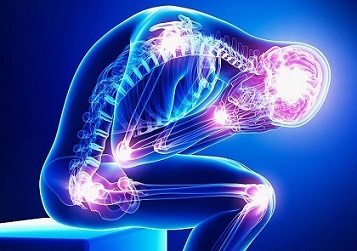Long COVID News: Study Shows That Neuropathic Pain Affects Up To 34.3 Percent Of Individuals With Long COVID
Long COVID News - Neuropathic Pain Feb 22, 2023 2 years, 9 months, 3 weeks, 3 days, 21 hours, 54 minutes ago
Long COVID News: A study by researcher from University of Sheffield-UK, University of Cyprus-Cyprus and Kapodistrian University of Athens-Greece has found that the prevalence of neuropathic pain among Long COVID individuals is about 34.3 percent!

To date, it has already been established that the SARS-CoV-2 coronavirus that is responsible for the ongoing COVID-19 pandemic, may impact other systems apart from the respiratory system, including the nervous system. One under-researched complication is the development of neuropathic pain following a COVID-19 infection.
The study team conducted a systematic review with the aim to establish the prevalence and determinants of neuropathic pain amongst COVID-19-infected individuals.
An extensive literature search in the PubMed database was performed and 11 papers were eligible for inclusion in this systematic review and meta-analysis.
The study findings showed that the pooled prevalence of COVID-19-related neuropathic pain was 6.7% (95% CI: 4.7–9.5%) for hospitalized patients during the acute phase and 34.3% (95% CI: 14.3–62%) for long COVID patients.
Interestingly, the identified risk factors for COVID-19-related neuropathic pain development included depression, COVID-19 severity and azithromycin use.
The study findings confirmed that neuropathic pain is a very common symptom in long COVID, indicating the urgency for further research in this direction.
The study findings were published in the peer reviewed Journal of Clinical Medicine.
https://www.mdpi.com/2077-0383/12/4/1672
A previous
Long COVID News coverage had also shown that SARS-CoV-2 infections leads to increased occurrences of peripheral neuropathy symptoms and pain.
https://www.thailandmedical.news/news/washington-university-study-reveals-that-sars-cov-2-infections-increases-occurrences-of-peripheral-neuropathy-symptoms-and-pain
Typically, neuropathic pain is caused by somatosensory nervous system diseases or lesions. Many risk factors for the pathogenesis of neuropathic pain have been identified, including systemic diseases, autoimmune diseases, incisions, channelopathies, metabolic disorders, viral infections and chemotherapy drug-induced mechanisms.
Though the exact molecular mechanisms are still to be discovered, neuropathic pain is estimated to affect up to 10% of the general population.
https://www.tandfonline.com/doi/abs/10.1080/14728222.2019.1550075
Worryingly, neuropathic pain has the potential to become severely debilitating, hugely impacting the quality of life of an individual. Associated autonomic symptoms can also inflict long-term disabilities. Mobility issues can limit socialization and independence, leading to depres
sion, anxiety and sleep disorders.
Furthermore, neuropathic pain often presents with analgesic/opioid medication resistance, leaving treatment options limited and tailored to the individual.
This highlights the necessity for neuropathic pain assessments across different cohorts, including COVID-19.
The exact prevalence of COVID-19-related neuropathic pain is unestablished to date.
https://pubmed.ncbi.nlm.nih.gov/33537521
It has been found that COVID-19 is able to interact with the nervous system via multiple mechanisms, promoting nociceptor excitability and, therefore, neuropathic pain.
https://journals.lww.com/painrpts/fulltext/2021/01000/neurobiology_of_sars_cov_2_interactions_with_the.1.aspx
Existing evidence suggests that neuropathic pain is occasionally an immediate COVID-19 complication; in other cases, it is more delayed.
In this systematic review, we aimed to establish the prevalence and determinants of COVID-19-related neuropathic pain by systematically applying eligibility criteria and performing a quantitative analysis.
https://link.springer.com/article/10.1007/s11916-022-01065-3
Though neuropathic pain can be a symptom in the acute phase of COVID-19 (the pooled prevalence for hospitalized patients was 6.7%), it is more common in the context of long COVID syndrome as it affects more than 1 in 3 sufferers (the pooled prevalence was 34.3%).
Current studies suggest that long COVID syndrome affects one in three of those infected with COVID-19.
https://pubmed.ncbi.nlm.nih.gov/34168002/
Hence, one in nine of those infected with COVID-19 will develop neuropathic pain. This is a significant number of people, considering the hundreds of millions who have been infected with COVID-19.
Interestingly, the COVID-19-related neuropathic pain predictors that proved to be significant in the literature included the COVID-19 severity (hospitalized cohorts), prolonged ICU prone positioning, azithromycin use and depression.
https://journals.lww.com/ajpmr/Fulltext/2022/05000/Musculoskeletal_and_Neurological_Pain_Symptoms.1.aspx
https://academic.oup.com/ptj/article/101/1/pzaa191/5929041
https://academic.oup.com/painmedicine/article/23/4/774/6472363
Psychological interventions to treat depression might prove useful in reducing the risk of COVID-19-related neuropathic pain. This is quite significant, considering 61% of COVID-19 patients were seeking neuropathic pain treatments at the follow-up.
https://onlinelibrary.wiley.com/doi/full/10.1002/acn3.51570
The study findings should be interpreted with caution, given a few limitations.
Firstly, a gender bias impacted certain samples, possibly preventing detectable differences from being uncovered. Future replications require equally balanced samples.
Secondly, most studies lacked control groups.
Thirdly, the literature search was restricted to a single database (PubMed). Despite the fact that PubMed is the largest medical database where the majority of (if not all) high-quality studies appear, there was a small risk that the study team might have missed a few relevant papers.
Lastly, publication bias may occur in systematic reviews and could have undermined the validity of the results. This was reflected in the significant heterogeneity among the studies of long COVID patients.
The study team concluded that their review highlighted the prevalence and predictors of COVID-19-related neuropathic pain.
Additional research is needed in the future to explore these findings in more detail, considering that several patients have been left unable to function due to neuropathic pain following COVID-19 [27].
https://neurologyindia.com/article.asp?issn=0028-3886;year=2022;volume=70;issue=2;spage=591;epage=595;aulast=Ocak
For the latest
Long COVID News, keep on logging to Thailand Medical News.
